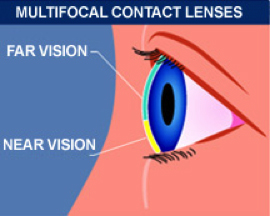You are probably much more active than your parents were at your age. Jogging, biking, playing sports and exercising are just a few of the activities that today’s 40-somethings routinely enjoy. Therefore, it’s no surprise that many people 40 and older prefer contact lenses over glasses for their lifestyles. When we reach our mid-40s, presbyopia makes it really difficult to focus on near objects. Reading glasses used to be the only option available to contact lens wearers who wanted to read a menu or do other daily tasks that require good near vision. But in modern times, a number of multifocal contact lenses options are available for one to consider. How do multifocal contact lenses work, and do they make sense for your eyesight? Multifocal contact lenses offer the best of both worlds: no glasses, along with good distance and near vision.
Differences Between Multifocal and Bifocal Contact Lenses
Multifocal contact lenses are mainly designed with a gradual transition between a prescription for very close reading on one end and a prescription for normal distance viewing on the other. They are similar to progressive eyeglasses. Bifocal contact lenses on the other hand, have a sharp edge between the near and far vision prescription areas of the lens. Many multifocal contact lenses have a bifocal design with two distinct lens powers — one for your near vision and one for distance. Other contact lenses have multifocal designs somewhat like progressive eyeglass lenses, with a gradual change in lens power for the natural visual transition from distance to close-up.
Types of Multifocal Contact Lenses
Multifocal contact lens comes in both soft lens and rigid gas permeable (RGP, or hard) lens materials. Soft lenses can be comfortably worn on a part-time basis, so they are great for weekends and other important occasions if you prefer not to wear them on an all-day, every day schedule. For ultimate in convenience, one-day disposable soft lens allows you to discard lens at the end of a single day of wear, so there is no hassle with lens care.
In some cases, GP multifocal contact lens provides sharper vision than the soft lens. But because of their rigid nature, GP contact lenses require some adaptation and are more comfortable if you condition the eyes by wearing the lenses every day. Hybrid multifocal contacts are an outstanding new alternative. These lenses have a very soft periphery and a GP center, making it easier to adapt.
Multifocal Designs
A commonly used contact lens design for individuals with presbyopia is the concentric bifocal pattern. In this type of contact lens, near correction is in a small circle at the center of the lens, properly surrounded by a much larger circle retaining the distance correction. The distance correction could be placed in the center instead, with near prescription in the outer ring. Beyond this familiar configuration, the two main multifocal contact lens designs are alternating and simultaneous image.
Alternating image designs have distinct zones in the lens for near vision and distance vision. These designs are available in gas permeable lens materials only. Like bifocal glasses, the top part of the alternating image multifocal GP lens is for the distance vision and bottom part is for near. These two zones are properly separated by a nearly invisible line that helps your eye care professional to determine if the contact lens is fitting properly.
Simultaneous image designs have both near and distance vision portions of the lens in front of the pupil at the same time. Simultaneous image designs are available in both soft and GP lens materials. Your brain must determine which area of the lens to emphasize and which area to ignore to provide the best image resolution.
Choosing multifocal contact lenses
Here are some pros and cons to weigh during and before the visit to your eye doctor.
Advantages of multifocal contact lenses
Multifocal contact lenses offer a range of benefits, among them:
- A less abrupt switch between prescriptions
- Better visual acuity for range of distances from near to far
- The ability to see in most conditions without extra eyewear
Drawbacks of multifocal contact lenses
Multifocal contact lens offers a lot of performance ability, but can also be:
- Accompanied by nighttime glare and hazy or shadowy vision during the adjustment period
- More difficult to adjust to due to different viewing experience
- More expensive because of the increased complexity in design
Your eye doctor is your best friend when you are thinking about getting contact lenses and other eye care decisions. Your doctor will help you find right corrective options for you to suit lifestyle, and evaluate you in the first four months to make sure the choice was appropriate. You can buy contact lenses online from online stores like Lenspick at a reasonable price.
